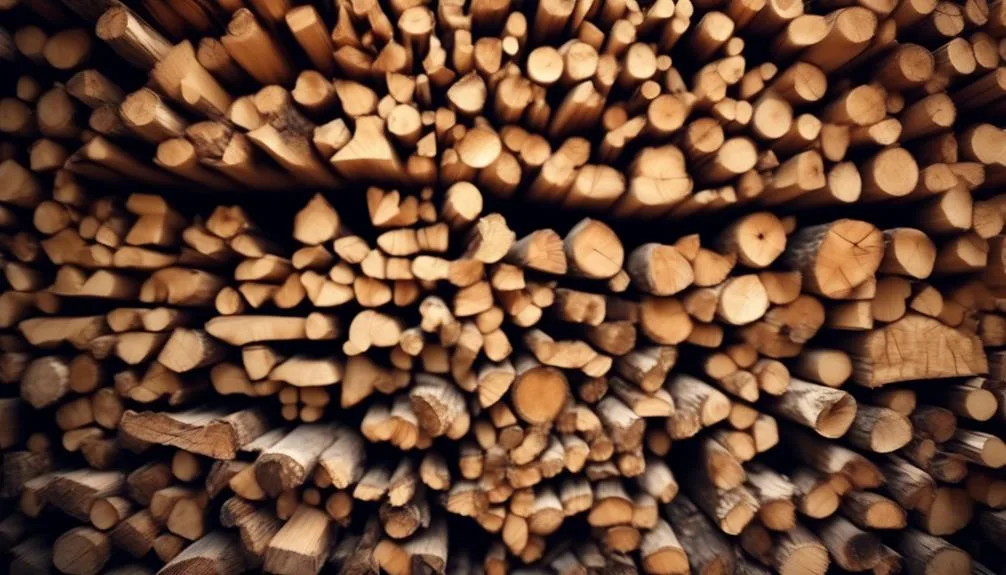Elm wood is often underestimated as firewood, but it's worth considering for its heating efficiency and safety.
Despite not being a popular choice, elm wood has potential benefits that are worth exploring. Before ruling it out, let's take a closer look at the characteristics and advantages of using elm wood for firewood.
It might just surprise you with its suitability for your heating needs.
Elm Wood Characteristics for Firewood
When selecting firewood, it's important to consider the characteristics of elm wood to ensure you're getting a quality and efficient fuel source for your needs. Elm wood is known for its excellent burning behavior, producing a steady and long-lasting heat.
However, it's crucial to note that elm wood requires a longer seasoning process compared to other types of firewood. Seasoning involves allowing the wood to dry out naturally, typically for six months to a year, to reduce its moisture content.
Properly seasoned elm wood will burn more efficiently, producing less smoke and creosote while maximizing its heat output. It's essential to invest the time in the seasoning process to fully enjoy the benefits of using elm wood as firewood.
Heating Efficiency of Elm Wood
To fully appreciate the heating efficiency of elm wood, it's crucial to understand how its excellent burning behavior and longer seasoning process contribute to its effectiveness as a fuel source for your heating needs. Elm wood is known for its high energy output and excellent burning qualities. It produces a steady, long-lasting heat, making it a reliable choice for heating your home. Elm wood also has a lower moisture content compared to other types of firewood, which further enhances its energy output and heating efficiency. In terms of environmental impact and sustainability, elm wood is a viable option as it is readily available and can be sustainably harvested. By choosing elm wood for your firewood needs, you are not only prioritizing heating efficiency but also making an environmentally conscious choice.
| Burning Qualities | Energy Output | Environmental Impact | Sustainability |
|---|---|---|---|
| High energy output | Steady | Low environmental impact | Sustainable harvesting |
| Excellent burning behavior | Long-lasting heat | Renewable resource | Readily available |
Seasoning and Drying Elm Firewood
Seasoning and drying elm firewood requires proper attention to moisture content and air circulation to ensure a high-quality fuel for your heating needs. Proper storage is essential for the seasoning process.
Split the wood and stack it in a single row, allowing air to circulate around each piece. Cover the top of the stack to protect it from rain but leave the sides open for airflow.
Elm wood has a high moisture content when freshly cut, so it's crucial to allow it to dry for at least six months to a year before use. This helps reduce smoke, increases heating efficiency, and minimizes environmental impact.
Well-seasoned elm firewood burns cleaner and hotter, making it a more environmentally friendly option for your fireplace or wood stove.
Elm Wood's Smoke and Residue
Wondering about the potential smoke and residue from burning elm wood? Elm wood tends to produce more smoke and residue compared to other types of firewood. However, there are ways to minimize pollution and keep your chimney clean when using elm wood for your fire. By ensuring that the wood is properly seasoned and dried, you can reduce the amount of smoke and residue produced. Additionally, regular chimney maintenance and cleaning can help prevent the buildup of creosote, a byproduct of wood burning that can lead to chimney fires. Here's a helpful table to illustrate the impact of smoke and residue from burning elm wood:
| Elm Wood's Smoke and Residue | Effect |
|---|---|
| More smoke | Increased air pollution |
| Higher residue | More frequent chimney cleaning required |
Safety Considerations for Elm Firewood
When using elm firewood, it's important to prioritize safety considerations, especially given its potential for increased smoke and residue compared to other types of firewood.
Here are some safety precautions to keep in mind:
- Ensure the elm firewood has a proper moisture content to prevent excessive creosote buildup in the chimney.
- Use proper burning techniques, such as building hot fires to minimize smoke production.
- Regularly inspect and clean your chimney to reduce the risk of a chimney fire due to creosote buildup.
- Store the elm firewood in a dry, well-ventilated area to prevent mold growth and maintain its burning efficiency.
- Always use appropriate safety gear, such as gloves and eye protection, when handling elm firewood to prevent injuries.
Prioritizing safety precautions, moisture content, burning techniques, and proper wood storage will ensure a safer and more enjoyable experience when using elm firewood.
Conclusion
In conclusion, elm wood is an excellent choice for firewood due to its high heating efficiency, easy seasoning, and minimal smoke and residue.
By following safety precautions, you can enjoy the reliable and efficient heat from elm firewood in your home.
Stay warm and bask in the comforting glow of elm firewood.

My interest in trees started when I first saw the giant sequoias in Yosemite.
I was a teenager then, and I remember thinking, “I need to learn more about this.”
That moment stuck with me.
A few years later, I went on to study forestry at Michigan Tech.
Since graduating, I’ve worked in a mix of hands-on tree care and community education.
I’ve spent over ten years helping people understand how to plant, maintain, and protect the trees in their neighborhoods.
I don’t see trees as just part of the landscape.
They are living things that make a real difference in our daily lives.
